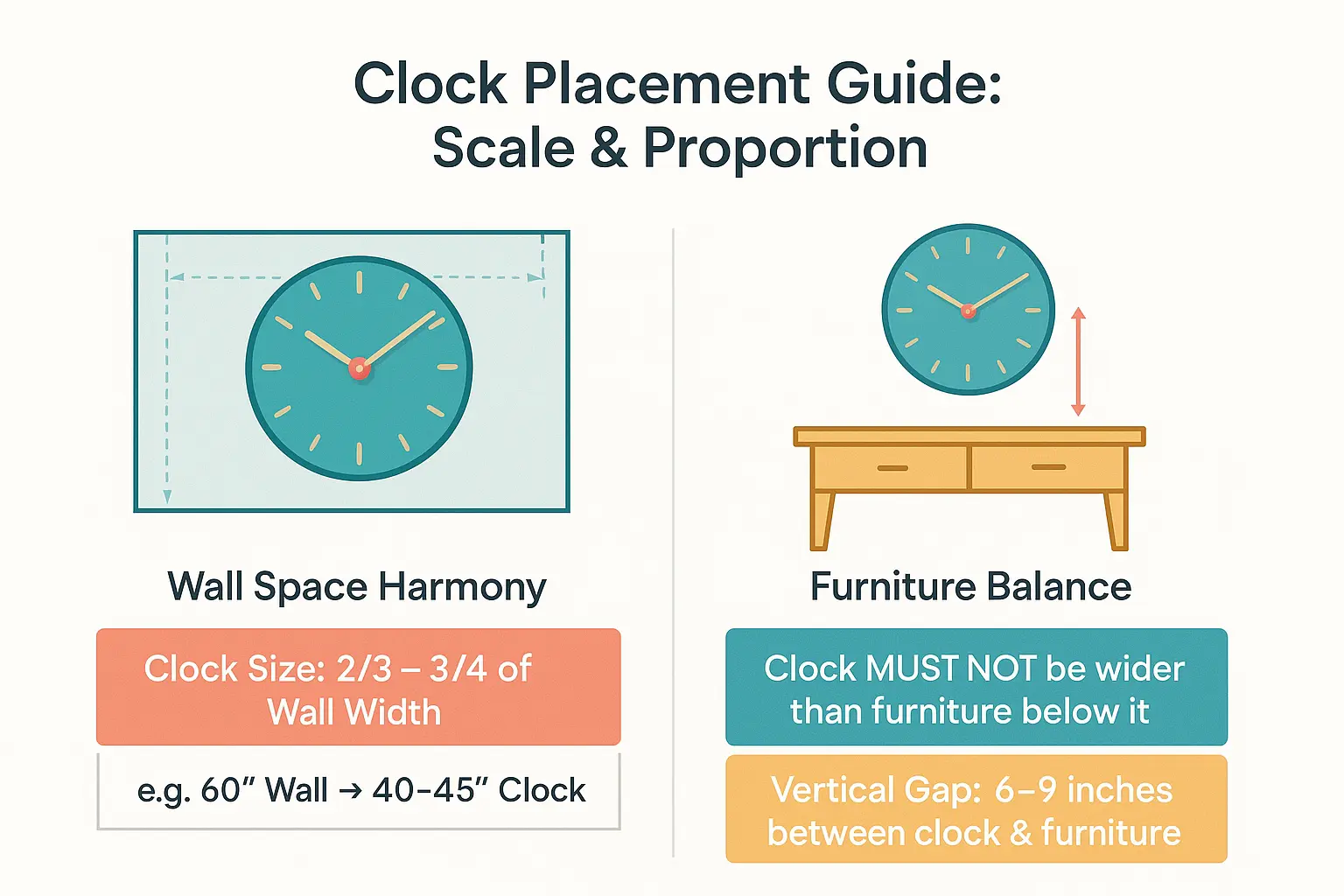How to decorate around a large wall clock?
The essential takeaway: A large wall clock acts as a bold statement piece, blending affordability with high visual impact. Placed above a fireplace or in a dining room, it adds personality. Matching rustic to modern designs ensures cohesion. As an art alternative, it transforms spaces stylishly and cost-effectively.
Struggling to decorate around a large wall clock without overwhelming your space or making it feel disconnected? You’re not alone. A large wall clock isn’t just functional—it’s a statement piece that can define a room’s personality, from modern minimalism to vintage charm. But without balancing scale and proportion, or blending it with complementary decor, it risks clashing with your style. This guide unlocks secrets to transforming your focal point into a showstopper, whether you’re framing it with floating shelves, pairing it with symmetrical elements, or anchoring an accent wall. Discover how to merge aesthetics and practicality, turning a timepiece into a timeless design win.
- Why a large wall clock is a game-changer for your decor
- Finding the perfect spot: strategic placement for your large wall clock
- Mastering scale and proportion: getting the balance right
- How to decorate around a large wall clock: creative ideas
- Harmonizing styles and colors for a cohesive look
- Are large wall clocks still in style? Trends and modern takes
- Your clock, your statement: final thoughts for a stunning display
Why a large wall clock is a game-changer for your decor

A large wall clock transcends timekeeping—it’s a bold statement piece that instantly elevates your decor. Its dynamic design combines practicality with artistry, offering movement through ticking hands or melodic chimes that inject warmth into any space.
As natural focal points, oversized clocks (often 24+ inches) command attention like artwork. Their scale fills empty walls elegantly, whether in rustic farmhouse settings with weathered wood, industrial spaces with metallic finishes, or minimalist rooms featuring sleek designs. Their visual weight ensures they never fade into the background.
Versatility defines the large wall clock. A Parisian-themed piece above a fireplace sparks conversation. Coastal kitchens gain charm with distressed wood designs. Modern lofts find rhythm in geometric shapes mirroring architectural lines. Even non-functional clocks shine as sculptural art, blending intricate patterns with dimensional details to anchor any room’s aesthetic.
Finding the perfect spot: strategic placement for your large wall clock

Creating a central focal point
Above a fireplace is a classic choice that anchors the room. The mantel’s prominence draws the eye, making the clock a commanding centerpiece in living room layouts. For optimal proportions, select a clock two-thirds the width of the mantel. Position above a sofa with 6-8 inches of spacing for symmetry, balancing the room’s proportions.
In entryways, a console table beneath adds depth, transforming narrow spaces into cohesive vignettes. Pair with a table lamp or greenery to enhance the composition.
Functional and stylish locations
Beyond traditional spaces, dining rooms gain visual impact from a bold clock, enhancing gatherings. In the kitchen, place it near countertops for quick time checks during meal prep, blending utility and style. A rustic design in a neutral-toned home office adds warmth, while metallic clocks pair with geometric desk organizers for modern workspaces.
Using architectural features to your advantage
Highlight a large empty wall by making the clock the sole focus. Between two windows, center it for symmetry, creating rhythm through visual balance. Keep surrounding decor minimal to avoid visual noise.
A large wall clock shouldn't just tell time; it should command attention. Choosing the right wall is the first step to creating a truly captivating focal point in your home.
Pair metallic clocks with bold art or let a textured accent wall emphasize the clock’s form. For modern spaces, opt for matte finishes; in vintage rooms, weathered wood or antique brass clocks thrive against shiplap or brick.
Mastering scale and proportion: getting the balance right

Choosing the right clock size for your-wall
To achieve scale and proportion, measure your wall space first. A large wall clock should occupy two-thirds to three-quarters of the available width. For instance, a 60-inch-wide wall suits a 40-45-inch diameter clock.
Consider room size and ceiling height. High ceilings often demand larger clocks (over 24 inches) to fill vertical space, while small rooms benefit from compact designs. Avoid oversized clocks that overwhelm the decor or undersized ones that get lost in large areas.
Use the "paper trick" for accuracy: outline the clock’s dimensions on paper and tape it to the wall. This prevents costly mistakes and ensures the right clock size aligns with your vision.
Balancing the clock with furniture
Ensure balancing the clock with underlying furniture. The clock’s width should never exceed the furniture’s width—whether a sofa, console, or buffet. This creates a harmonious visual and prevents imbalance.
Leave 4-6 inches (10-15 cm) between the clock’s bottom and the furniture’s top. This "breathing room" maintains clarity and avoids a cramped look. For example, a 36-inch-wide console pairs best with a 24-30-inch clock.
Position the clock so its center aligns with eye level or slightly above (e.g., 58 inches from the floor). This ensures visibility and integrates the clock as functional art, not a cluttered accessory.
How to decorate around a large wall clock: creative ideas
1. Create a gallery wall with the clock as the anchor
Transform your large wall clock into the centerpiece of a curated gallery wall. Arrange picture frames of varying sizes around the clock, blending family photos, small artworks, and textured accents like woven wall hangings. This approach creates visual interest while letting the clock anchor the display. For cohesion, stick to a consistent color palette for frames or mix metallic finishes that echo the clock’s design.
- A mix of small and medium picture frames
- One or two mirrors with interesting shapes
- Decorative signs or inspiring quotes
- Small, lightweight art objects or textured wall hangings
2. Flank it with symmetrical elements
Elevate the clock’s presence with a balanced, formal aesthetic. Place identical items on either side, such as matching sconces, vertical shelves, or tall potted plants. Symmetrical elements create a polished, intentional feel. For example, pair brass sconces with a gold-framed clock to enhance the symmetrical elements and achieve a balanced look.
3. Incorporate shelving for a layered look
Add depth by installing floating shelves beneath or beside the clock. A single long shelf below the clock can hold curated decor like colorful ceramics, books, or trailing plants. For a layered look, use staggered shelf heights and mix practical items (e.g., candles) with decorative pieces to avoid clutter.
4. Use mirrors to enhance light and space
Boost brightness and spatial perception by pairing the clock with mirrors. Arrange small, uniquely shaped mirrors—round, hexagonal, or sunburst—around a circular clock. This contrast adds dynamism while reflecting light to make the room feel larger. The strategic use of mirrors aligns with the principle of incorporating complementary artwork or mirrors.
5. Frame it with an accent wall
Make the clock pop against an accent wall. Opt for a bold hue like navy to contrast with a brass clock or a subtle patterned wallpaper to complement a neutral design. This technique draws attention to the clock while harmonizing with the room’s style. For example, a modern geometric wallpaper pairs well with a minimalist clock.
| Decor Idea | Best For (Style) | Pro Tip |
|---|---|---|
| Gallery Wall | Eclectic, Bohemian, Transitional | Use a consistent color palette for frames to create a cohesive look despite varied content. |
| Symmetrical Sconces | Traditional, Formal, Art Deco | Choose sconces that match the metal finish of your clock for a polished feel. |
| Floating Shelves | Modern, Scandinavian, Minimalist | Keep shelf decor simple and uncluttered to avoid distracting from the clock. |
| Accent Wall | Modern, Glam, Maximalist | Pick a color or pattern that complements, rather than competes with, the clock’s design. |
| Greenery/Plants | Farmhouse, Coastal, Bohemian | Use trailing plants like ivy or pothos to soften the hard lines of the clock and furniture. |


Harmonizing styles and colors for a cohesive look
Matching your clock to your home's aesthetic
Selecting the right wall clock style creates immediate visual harmony. Farmhouse or Rustic interiors suit reclaimed wood or galvanized metal finishes that complement natural textures. Consider a distressed oak clock with Roman numerals above a stone fireplace mantel to emphasize rustic authenticity.
- Industrial decor: Exposed gears and raw metal finishes match factory-inspired spaces with steel beams. A matte black clock works perfectly in loft apartments
- Modern/Minimalist: Clean lines and numberless faces maintain sleek sophistication. Choose matte white clocks with brushed aluminum frames
- Vintage/Shabby Chic: Ornate carvings and distressed finishes add nostalgic charm. A clock with faded motifs complements pastel walls
A guide to color coordination
Transform your space through strategic color coordination. The clock's frame and numerals should create visual continuity with decor elements. Brass hands could mirror metallic accents in artwork frames, while a black clock face might echo pendant lighting fixtures.
Use this formula: "Take one dominant clock color for 60% of decor, secondary color for 30%, and accents for 10%." A coastal living room might feature clock hands matching ceramic seashell accents on shelves, while urban spaces could mirror metallic tones in geometric planters.
Contrasting shapes for visual interest
True harmony in design isn't just about matching everything. It's about creating a conversation between shapes, colors, and styles to build a space that feels uniquely yours
Break geometric monotony with contrasting shapes. A circular clock becomes dynamic above a rectangular fireplace mantel. Modern spaces gain softness through curved clock faces, while traditional rooms benefit from arched-top rectangular clocks.
Balance visual weight by pairing angular furniture with round clocks. A dining room with square windows gains dimension from a circular clock echoing dining chairs' curves. In kitchens, combine angular subway tiles with round clocks to soften industrial lines.

Are large wall clocks still in style? Trends and modern takes
Large wall clocks not only remain still in style but have transformed into versatile decor elements blending function with artistry. Far from outdated timekeepers, these pieces now serve as bold statements in contemporary design.
Current trends emphasize timeless appeal through innovative materials and forms. Natural elements like reclaimed wood and brass accents dominate, while oversized frames in matte black or gold add modern sophistication. Designers increasingly integrate clocks into decorative panels or combine them with floating shelves for dual functionality.
- Minimalist Designs: Oversized faces with subtle metallic hands and no numerals create sleek focal points.
- Natural Materials: Walnut, solid wood, and travertin-inspired finishes bring organic warmth to modern spaces.
- Integrated Functionality: Multi-purpose clocks featuring built-in lighting or floating shelves gain popularity.
- Silent Mechanisms: Over 78% of 2024's top-rated clocks prioritize non-ticking movements for serene environments.
Interior experts reveal that oversized clocks (32"+ diameter) solve two common decor challenges: filling vertical space dramatically while maintaining practicality. Their ability to anchor a room's aesthetic makes them favored choices for living rooms, dining areas, and home offices seeking curated charm.
From geometric metal accents in urban lofts to distressed wood frames in farmhouse kitchens, these clocks adapt across styles. The key lies in matching clock finishes to existing hardware - pairing a bronze clock with brass light fixtures, or a white minimalist design with clean cabinetry lines.
Your clock, your statement: final thoughts for a stunning display
Your large wall clock isn't just a timekeeper—it's a canvas for your personal style. By choosing a strategic focal point, balancing scale with surrounding decor, and harmonizing colors and textures, you've transformed a functional object into a storytelling centerpiece.
Don't shy away from experimentation. Whether your space leans industrial or farmhouse, let your clock reflect your journey.
Ultimately, the best way to decorate around your clock is to surround it with things you love. Let it be the centerpiece of a wall that tells your story, not just the time.

Remember, a well-decorated clock display isn't about rigid rules—it's about creating visual harmony that feels authentically you. With these principles in mind, your wall becomes more than a time display; it becomes a gallery of your life.
A well-placed large wall clock becomes more than a timekeeper—it’s a bold statement piece. Balance its scale with surrounding furniture, harmonize colors for cohesion, and let your personal style guide the decor. Whether modern or vintage, strategic placement transforms it into a captivating focal point. Embrace creativity; let your clock reflect your story, not just the hour.
FAQ
What are the best complementary pieces to place beside a large wall clock for balanced decor?
To create visual harmony, flank your clock with symmetrical elements like matching sconces, identical floating shelves, or potted plants with similar height and foliage. For a minimalist look, opt for sleek candle holders or geometric sculptures. If your space leans eclectic, mix in framed art or textured wall hangings. The key is to maintain balance while ensuring the clock remains the focal point.
Are oversized wall clocks still a stylish choice for modern interiors?
Absolutely! Large wall clocks remain a timeless decor staple, evolving to align with current trends. Minimalist designs with clean lines, natural materials like reclaimed wood or brass, and silent mechanisms are particularly popular. Their ability to anchor a room’s aesthetic while serving a functional purpose ensures they stay relevant in 2025 and beyond.
How can I arrange decor on both sides of a large clock for symmetry?
Symmetry creates a polished, intentional look. Place identical items—such as matching table lamps, wall sconces, or decorative mirrors—on either side of the clock. For a modern twist, use vertical shelves or tall indoor plants like fiddle-leaf figs. This approach enhances balance while allowing the clock to command attention as the centerpiece.
What’s the best way to integrate framed photos or art around a wall clock?
Treat the clock as the anchor of a gallery wall. Arrange smaller frames in a mix of sizes and orientations around it, ensuring a cohesive color palette for frames or mats. Incorporate mirrors or lightweight sculptures to add depth. Leave 4-6 inches between each piece to avoid clutter, and use the clock’s style (e.g., vintage, industrial) to guide your decor choices.
Which large wall clock styles are trending in contemporary decor?
Current favorites include minimalist clocks with open faces and no numerals, designs in natural materials like matte black metal or marble, and clocks with integrated shelves or silent movements. Ornate antique replicas and thematic pieces (e.g., Parisian motifs or industrial gears) also appeal to niche tastes, blending functionality with artistic flair.
Where should I position a large clock in a living room for maximum impact?
Prioritize natural eye-level spots like above a fireplace mantel, sofa, or console table. These locations naturally draw attention and anchor the space. For dramatic effect, place it on a large empty wall or between two windows to frame the area. Ensure the clock is visible from seating areas and harmonizes with nearby furniture proportions.
Will wall clocks become outdated in 2025, or are they a lasting choice?
Wall clocks are far from outdated—they’re a lasting decor element that adapts to trends. In 2025, expect to see more customization, such as clocks with interchangeable faces or smart features. Their enduring appeal lies in their dual role as functional art, making them a versatile addition to any room when styled thoughtfully.
What is the term for those classic oversized pendulum clocks?
They’re commonly called grandfather clocks. These tall, freestanding timepieces often feature wooden cases and pendulum mechanisms. While traditionally associated with formal spaces, modern interpretations blend into contemporary settings with sleek finishes and compact designs, proving their timeless charm.
What wall clock color works best in a bedroom for a calming atmosphere?
Opt for soft, neutral tones like muted grays, warm beiges, or matte black for a serene vibe. For vibrant bedrooms, choose clocks with accents that echo existing hues (e.g., brass for golden tones, sage green for earthy schemes). Avoid overly bright or reflective finishes to maintain a restful ambiance.
If design sets the mood, Vastu sets the compass. Here’s how to choose a wall clock, style, location, and symbolism, that keeps both beauty and blessings on time.
